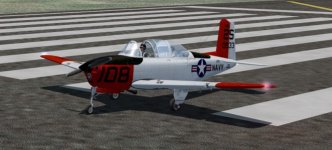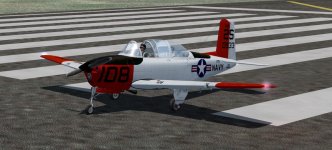Thanks for that! I really appreciate your insights. I am saving this for my future ref.
In doing some more research and recollection from my 78 year old brain, A few points from this old map.
The map has to be post 1951, because Forest Sherman field was commissioned in 1951. Before that, Chevalier Field
was NAS Pensacola. Apparently what the Navy did was simply expand the area of Chevelier to build the new Forest Sherman Field, combining both into what is now NAS Pensacola ("Mainside"). Chevalier gradually degraded as an airfield, instead hosting a wide assortment of schools and other functions including the main hospital and Naval Rework Facility (NARF) Pensacola.
The various schools for both officers and enlisted personnel have bounced around in their location over the years. In my day (1965), what was known as pre-flight schooling for commissioned officers (normally Ensigns out of USNA or ROTC) was held at Mainside. AOCS NAVCADs also had their full course training there. Forest Sherman hosted VT-4 with T-2As for basic carquals for all basic jet students (all were transferred TAD from NAS Meridian). In addition it had a fairly large gaggle of C-47s, C-54s, C-118s, SNBs ad HU-16s. These were typically flown by instructors from all over the Pensacola area to maintain flight time, especially night and instrument time, because teaching ground classes or primary flight at Saufley was not sufficient to keep proficient.
The various and numerous Navy fields in the area need some illumination. NAAS is an aux airfield. They could host training squadrons but did not have a large administrative capability (hospital, commissary, NEX, personnel departments, etc - maybe just very limited) but came under the umbrella of Mainside. An Outlying Landing Field (OLF) was/is just that - no permanent facilities, just for touch and goes, not even a tower. In some cases special OLFs were for FCLP carrier practice, and LSOs would land there and park. A Navy fuel truck and minimum ground crew would drive out in the morning to fuel and start airplanes involved in FCLPs. A common routine for a student was to make touch and goes until low on fuel, land, shut down and debrief with the LSOs. They would refuel, start and launch into the pattern again, but depart to home field when their fuel was down to Return To Base (RTB) level. This process was common to both VT-4 (T-2s) and VT-5 (T-28Cs). Typical FCLPs were 4 or 6 students at a time in the pattern.
I got to get a quickie helo transition course as a LCDR prior to going to Test Pilot School - what a deal! As best I recall, there were dedicated helo OLFs - no runways, but designated, numbered grass "blocks" to practice hovering and "squat and go" circuits. I can't remember which ones though.
If I may digress even more - when I was "bouncing" in VT-4 T-2As, we sometimes used a field called Eglin Aux 6. What was interesting was that it was where the Navy trained Doolittle's B-25 pilots for carrier takeoffs. During inter-period debriefs the LSOs would make sure all of us had a chance to look at a stone mounted brass plaque that memorialized the site. It made quite an impression on all of us.
Other OLFs were where students (both dual and solo) practiced touch and goes - Saufley (T-34Bs), Whiting (T-28B/Cs) and Ellyson (helos) could not handle the volume required, so these fields were the solution. Patterns in the area used the radio for each field in sort of a UNICOM operation, flying around the area uncontrolled via prescribed course rules. How the hell we never had any mid-airs is beyond me! It was an extremely busy area during the day.
This is not particularly helpful in your work on CORRY, but perhaps helps narrow down the time frame and general atmosphere the map (and evolution) indicates.












 Now a days, it's Beemers (BMW) and Mercedes and a 'vette here and there.
Now a days, it's Beemers (BMW) and Mercedes and a 'vette here and there.